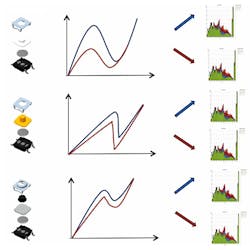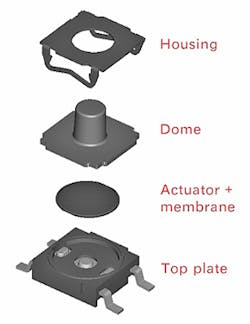Since the dawn of the electronics age, much of the design consideration for interface controls in consumer appliances and automotive interiors focused on the basic functionality of a limited number of switches responsible for operating relatively uncomplicated electrical and electronic systems. As electronics design evolved and a higher premium was placed on comfort and convenience features, the aesthetic characteristics of these controls became a higher priority.
In response, designers began to implement ergonomics into switch selection, primarily through the layout and functionality of these various controls. However, now that advanced electronic technology pervades throughout consumer appliances and automobile interiors, design engineers must consider a more holistic approach when selecting their interface controls, including touch, feel, and sound characteristics.
This file type includes high resolution graphics and schematics when applicable.
Haptics and Acoustics Invade Interface Controls
Haptics, the science and physiology of the human sense of touch, and acoustics, the science of audible sound perception, now play an increasingly critical role in user-interface design targeting electronic controls. How switches look, feel, and sound have become integral to the marketing process for different consumer and automotive brands. By integrating haptics and acoustics into ergonomic and visual designs, design engineers can leverage necessary interface controls to help reinforce the overall brand identity of their products as experienced by consumers. This can effectively contribute to the perception of a manufacturer’s quality and differentiate between brands.
When conventional automotive and appliance switch designs were primarily electromechanical, the mechanics involved robust pushbutton switches with relatively long travel (the measured specification for the distance required to actuate a switch). However, as these control subsystems evolved from electromechanical to electronic, user tastes also evolved. For today’s consumers—many of whom grew up with handheld electronics, such as smartphones, and are therefore more comfortable and familiar with short travel switches—less travel is more.
In fact, many consumers now consider the old-style long travel switches to have an indeterminate feel of lesser quality. As such, user-interface controls now overwhelmingly demand smaller tactile switches with much shorter travel (< 0.8 mm).
These short travel tactile switches typically include a metallic snap-dome contact system that provides the interface between the actuator and the switch housing. Metallic domes maintain longer lifespans and shorter travel than silicon materials, which are both desirable consumer characteristics, but do produce an audible sound during actuation and release.
As a result, design engineers are now also challenged with controlling the acoustic performance of these switches to produce a consistent sound. That’s because more appliance and automobile manufacturers now issue detailed specifications for consistent haptic and acoustic performance of these interface controls to influence brand-quality perceptions and reinforce brand loyalty (Fig. 1).
Multiple Factors Determine Switch Acoustics
The sound generated by a tactile switch derives from several factors: the composition of the dome, the overall structural design of the switch body, and the way the switch is integrated into the larger system it controls. Acoustics for these short-travel switches are typically measured using a spectrum of sound frequencies within an audible bandwidth. Such distributions illustrate the sound’s “color” within the spectrum and indicate the two distinct sounds generated by the switch’s actuation and release (Fig. 2).
Any given tactile switch presents several design challenges with regard to characterizing and evaluating its acoustic performance. The foremost concern when characterizing the sound generated by a tactile switch is the structure of the component itself. Individual elements within the switch (e.g., dome composition and characteristics, actuator types, materials, and overall dimensions) are key variables that should be determined for each switch. Different internal switch configurations will produce different acoustic patterns and, hence, different sound profiles (Fig. 3).
Sound quality is inherently subjective, and ultimately determined by end users. Many people know and appreciate their preferred sound when they hear it. However, they’re often unable to objectively specify its definition, which makes defining switch acoustics even more challenging. By considering, testing, and selecting various switch structure and materials configurations, though, designers can achieve a satisfactory compromise between the desired haptics targets and the actual generated sound.
For example, the pre-installation sound characteristics of a switch response may be altered through various process parameters, such as soldering to the printed circuit board or overall structural effects caused by the switch being installed, which can also affect the sound output. Further, the overall consistency of sounds generated by multiple tactile switches within the same control system must be measured, controlled, and maintained post-installation to achieve the desired acoustic performance.
Integrating Touchscreen Technology and Tactile Switches
For certain clusters of interface-control groups, integrating a traditional electromechanical control system—replete with a large-area touch-sensitive surface or a tactile screen on the center console of a dashboard or appliance—can be advantageous. Combining low-profile tactile switches with a wider actuating superstructure creates a large clickable area with a consistent haptic sensing surface capable of controlling multiple functions.
This switch technology integration, featuring a structure of supporting points linked to low-profile tactile switches along the edge of the screen and actuators on the screen surface, transmits the force from the touching surface to the edge switches with minimum distortion and power consumption. The end result is a smooth, consistent haptic feel across the entire surface. The design also has the added advantage of incorporating several functions within a single surface, which frees up the physical space required for several independent keys or switches.
Flexible Manufacturing Process Helps Achieve Consistency
The ability to design, manufacture, test, and deliver user-interface controls that meet this type of consistent haptic and acoustic specification requires a switch supplier with extensive experience in developing the required high-performance parameters. Experience in delivering high-performance switching products required for high-volume consumer applications, especially for manufacturers with stringent design and performance requirements, fosters the development of unique manufacturing concepts. Such concepts can produce custom switch solutions that consistently surmount the challenges presented by contemporary haptic and acoustic requirements for consumer electronics controls.
For example, developing and maintaining fully integrated manufacturing processes for tactile switches allows manufacturers to adapt key components in the switch construction. Consequently, they’re able to achieve the consistent haptic and acoustic performance sought by design engineers, especially when augmented with a range and depth of experience in applying and adapting various switch technologies for specific applications.
The exploded assembly view in Figure 4 shows the components of a short-travel tactile switch. The critical component in determining the haptic and acoustic characteristics of such a switch is the metallic snap dome. By using a flexible manufacturing process, the dome’s characteristics can be tuned and adapted to meet design engineers’ individual requirements for a host of different factors, including actuation force, travel distance, snap ratio, tolerance, acoustics, and other haptic behavior.
Flexible manufacturing processes are crucial enabling technologies for configuring highly customized tactile-switch product lines that incorporate the exact components, dome materials, and dimensions necessary to achieve the desired haptic and the acoustic performance levels. Though this approach requires a fully integrated manufacturing process and a method of tuning the switch to adjust sound, it can result in a vastly greater range of haptic and acoustic performance specifications than that available in predetermined switch components.
Manufacturing and design experience is also key to satisfying specifications as precise and subjective as switch acoustics and haptic elements. Simply put, experienced switch suppliers can better define the structure and material selection best suited for a given application. For the OEM, this experience represents a significant advantage in terms of manufacturing cost, time to market, and risk reduction.
Another way to facilitate the design process is to seek out switch suppliers that can provide several different product samples during the design phase to highlight potential variations in volume production given the tolerance limits of key elements, such as the dome. This service gives design engineers the ability to accurately assess the haptics and acoustics performance/consistency of switches under real-world conditions during the design phase. Therefore, they can more safely ensure that the final product satisfies all desired specifications in a timely, efficient, and cost-effective manner.
This file type includes high resolution graphics and schematics when applicable.
Achieving the exact haptic and acoustic results increasingly in demand for contemporary consumer electronics and automotive interior controls is a complex, multi-step process. However, with the help of switch suppliers that provide expert technical knowledge, flexible manufacturing processes, and product samples throughout the design process, OEM engineers can easily optimize their manufacturing techniques to satisfy consumer demands.
Eric Grange, industry market manager, Automotive, for C&K Components, studied materials and mechanical engineering (MSc) at the Polytechnic School of the University of Orléans. He has been a product manager at C&K Components for just over 10 years, and was previously a product and project manager at Amphenol.






